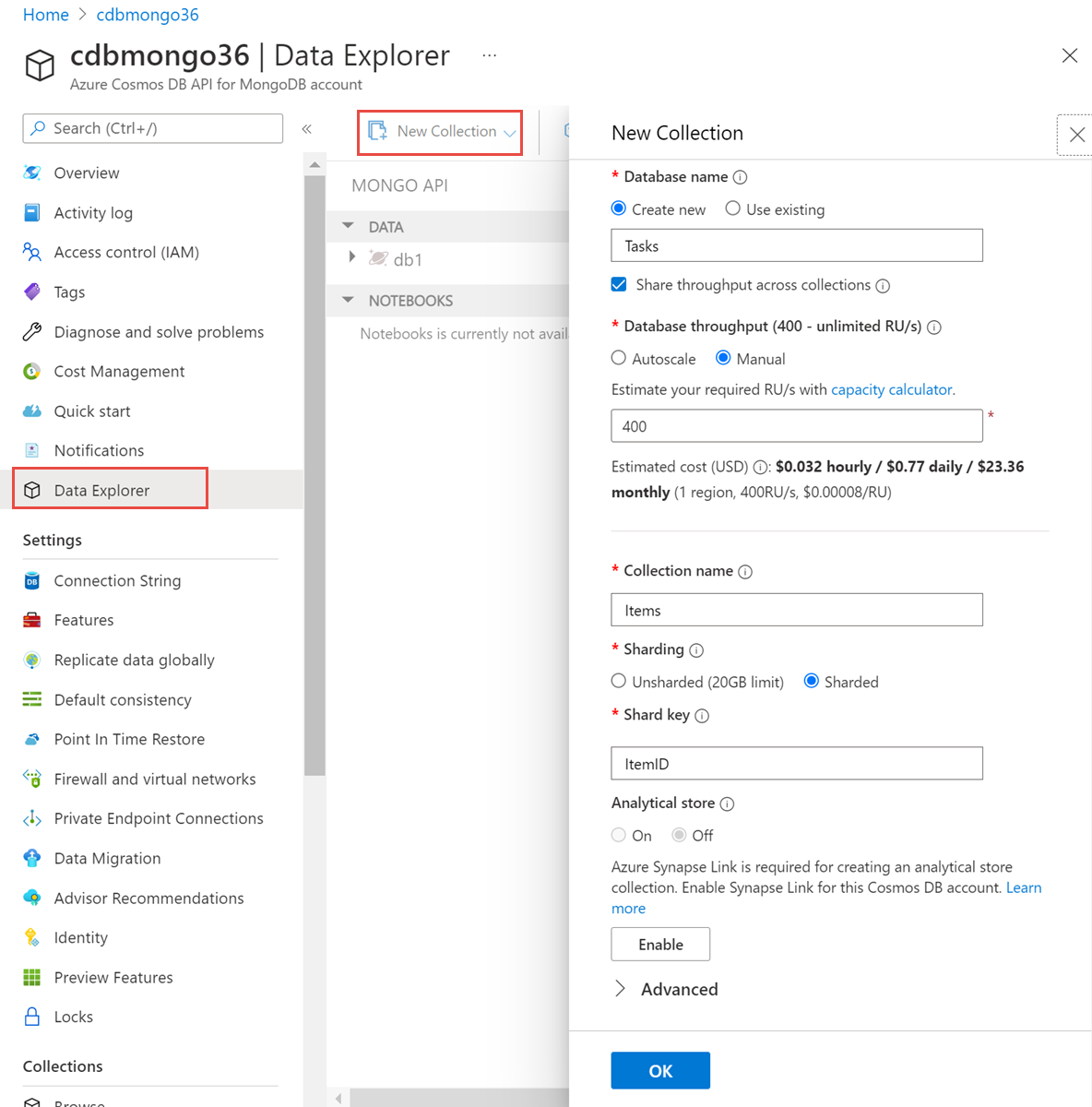你当前正在访问 Microsoft Azure Global Edition 技术文档网站。 如果需要访问由世纪互联运营的 Microsoft Azure 中国技术文档网站,请访问 https://docs.azure.cn。
在 Azure Cosmos DB for MongoDB 资源上预配数据库、容器或自动缩放吞吐量
适用对象: MongoDB
本文介绍如何在 Azure Cosmos DB for MongoDB 中预配吞吐量。 你可在一个容器或数据库上预配标准(手动)或自动缩放吞吐量,并在数据库中的容器之间共享。 你可使用 Azure 门户、Azure CLI 或 Azure Cosmos DB SDK 来预配吞吐量。
如果使用的是其他 API,请参阅 API for NoSQL、API for Cassandra、API for Gremlin 这几篇文章来预配吞吐量。
Azure 门户
登录 Azure 门户。
新建 Azure Cosmos DB 帐户,或选择现有的 Azure Cosmos DB 帐户。
打开“数据资源管理器”窗格,然后选择“新建集合” 。 接下来,请提供以下详细信息:
- 表明要创建新数据库还是使用现有数据库。 如果要在数据库级别预配吞吐量,请选择“预配数据库吞吐量”选项。
- 输入集合 ID。
- 输入分区键值(例如
ItemID)。 - 输入要预配的吞吐量(例如,1000 RU)
- 选择“确定”。

注意
如果要在配置了 Azure Cosmos DB for MongoDB 的 Azure Commos DB 帐户中的容器上预配吞吐量,请使用 myShardKey 作为分区键路径。
.NET SDK
// refer to MongoDB .NET Driver
// https://docs.mongodb.com/drivers/csharp
// Create a new Client
String mongoConnectionString = "mongodb://DB AccountName:Password@DB AccountName.documents.azure.com:10255/?ssl=true&replicaSet=globaldb";
mongoUrl = new MongoUrl(mongoConnectionString);
mongoClientSettings = MongoClientSettings.FromUrl(mongoUrl);
mongoClient = new MongoClient(mongoClientSettings);
// Change the database name
mongoDatabase = mongoClient.GetDatabase("testdb");
// Change the collection name, throughput value then update via MongoDB extension commands
// https://learn.microsoft.com/azure/cosmos-db/mongodb-custom-commands#update-collection
var result = mongoDatabase.RunCommand<BsonDocument>(@"{customAction: ""UpdateCollection"", collection: ""testcollection"", offerThroughput: 400}");
Azure 资源管理器
Azure 资源管理器模板可用于在数据库或容器级资源上为所有 Azure Cosmos DB API 预配自动缩放吞吐量。 有关示例,请参阅 Azure Cosmos DB 的 Azure 资源管理器模板。
Azure CLI
Azure CLI 可用于在数据库或容器级资源上为所有 Azure Cosmos DB API 预配自动缩放吞吐量。 有关示例,请参阅用于 Azure Cosmos DB 的 Azure CLI 示例。
Azure PowerShell
Azure PowerShell 可用于在数据库或容器级资源上为所有 Azure Cosmos DB API 预配自动缩放吞吐量。 有关示例,请参阅适用于 Azure Cosmos DB 的 Azure PowerShell 示例。
后续步骤
请参阅以下文章,了解如何在 Azure Cosmos DB 中预配吞吐量:
- Azure Cosmos DB 中的请求单位和吞吐量
- 尝试为迁移到 Azure Cosmos DB 进行容量计划? 可以使用有关现有数据库群集的信息进行容量规划。
- 如果只知道现有数据库群集中的 vCore 和服务器数量,请阅读使用 vCore 或 vCPU 估算请求单位
- 若知道当前数据库工作负载的典型请求速率,请阅读使用 Azure Cosmos DB 容量计划工具估算请求单位